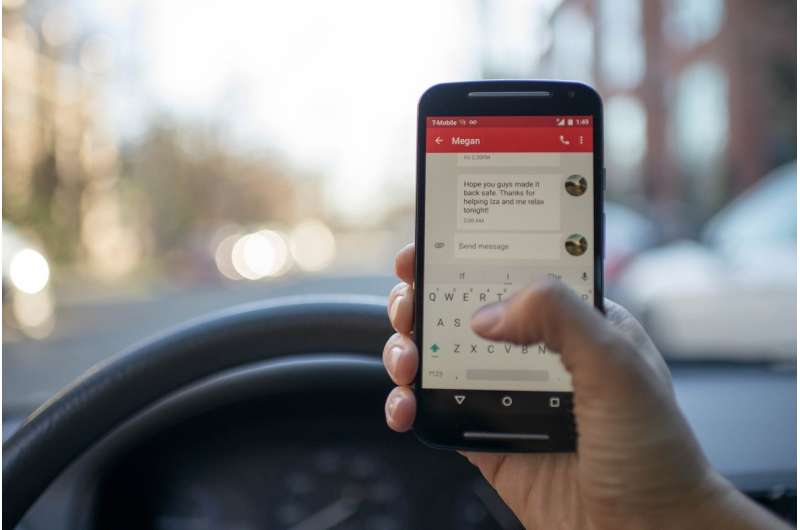Nearly two in five teen drivers text while driving

Cellphone use while driving has been estimated to increase crash risk by 2-9 times and texting while driving may be especially risky because it involves three types of driver distraction: visual (eyes off the road), manual (hands off the wheel), and cognitive (attention away from driving).
A new study led by the Center for Injury Research and Policy at Nationwide Children's Hospital examined individual- and state-level factors associated with texting while driving among teens. The study, done in conjunction with researchers from the Centers for Disease Control and Prevention (CDC) and The Ohio State University, looked at Youth Risk Behavior Survey data from 35 states.
The study, published today in Journal of Adolescent Health, found that nearly 2 in 5 teen drivers age 14 years and older had texted while driving at least once in the month prior to the survey, despite the fact that 34 of 35 states in the study ban text messaging for drivers 21 years and younger.
Texting while driving prevalence varied by state, from 26% in Maryland to 64% in South Dakota. More teens texted while driving in states with a lower minimum learner's permit age and in states where a larger percentage of students drove. White teens were more likely to text while driving than students of all other races/ethnicities. Texting while driving prevalence doubled between ages 15 and 16 years, and it continued to increase substantially for ages 17 years and up.
"The increase in texting while driving at the age when teens can legally begin unsupervised driving was not surprising," said Motao Zhu, MD, MS, Ph.D., the study's lead author and Principal Investigator in the Center for Injury Research and Policy at Nationwide Children's Hospital. "Graduated driver licensing laws could have an impact on texting while driving behavior: the earlier teens start driving, the earlier they start texting while driving."
The five states where more than 50% of teen drivers reported texting while driving had a learner's permit age of 15 years or younger.
Teens who engage in other risky driving behaviors were also more likely to text while driving. Teen drivers who didn't regularly wear seatbelts were 21% more likely to text while driving compared to frequent seatbelt users. Teens who reported drinking and driving were almost twice as likely to text while driving compared to those who did not.
"Risky driving behavior is known to be much less common with an adult in the car," said Ruth Shults, MPH, Ph.D., formerly, senior epidemiologist with the CDC's Division of Unintentional Injury Prevention. "The association between age and texting while driving highlights the need for parents to pay attention to their child's texting while driving throughout the teen years—not just when their children are learning to drive."
The data from this study is likely an underestimate of teen drivers' cellphone use. The survey question asked specifically about "texting and emailing while driving," and therefore does not measure the full range of ways that teens use their cellphones while driving, including answering or placing a phone call, accessing social media, playing music, and using other apps. It's also possible that students who took the survey considered reading a text or email to be different from writing or sending a message. And some may not have considered texting while their vehicle was stopped at a light as texting while driving. All these could lead to underreporting of the behavior.
Parents can help limit their teens' texting while driving behavior by doing the following:
- Be a good role model. Teens are more likely to use their cellphones while driving if they see their parents doing it. If having your cellphone on and within reach while driving is tempting, put it on silent so you won't hear notifications. Try putting it in the trunk or backseat compartment or locking it in the glove box so you can't reach it while driving. If you cannot or do not want to put your cellphone away completely, ask a passenger to make and answer calls, read and reply to texts, or look at the calendar as you make plans.
- Be patient. If you know your teen is driving, wait until he arrives before you text or call. Teens report that they are more likely to respond to a call or text while driving if it is from a parent, close friend, or boyfriend/girlfriend.
- Set clear rules about prohibiting all cellphone use while driving. Make sure to communicate those rules clearly and enforce them.
- Continue to monitor new drivers. Keep riding with your teen even after he gets his license. Compliment your teen's safe driving behaviors and remind him of the rules when he makes poor decisions.
- Take advantage of built-in features. Many phones have a driving mode you can turn on to disable texting, calling, or other functions while in motion. Consider having your teen use this mode or installing an app—some of which will send immediate notifications to parents—with a similar purpose.

















